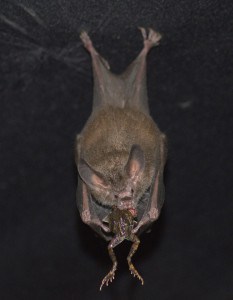Share this article
How bats hunt in noise pollution
Robotic frogs with inflatable throat pouches are revealing how bats hunt in noisy conditions. Ordinarily, the bats locate their amphibian prey by following frog mating calls. But when noise pollution drowns out frogs’ voices, bats increase their use of echolocation, zeroing in on frogs’ moving throats.
“Bats have this strategy to switch between senses,” said Wouter Halfwerk, a behavioral ecologist at the University of Amsterdam and senior author of a new study in Science magazine. “They shift their attention from passive hearing, because there’s masking interference from the noise, to active echolocation.”
Researchers have long known that humans can use one sense to compensate for another. For example, in the famous “cocktail party problem,” people can watch the movement of a speaker’s lips to help them pick out one voice among many. Some researchers have proposed that animals might use similar strategies, compensating for traffic noise or artificial lights by using input from other senses. But until now, says Halfwerk, no one had put this to the test. Researchers studying sensory pollution have only looked at one sense at a time, documenting patterns such as higher-pitched singing among birds that need to be heard over traffic.

A fringe-lipped bat eats a captured frog. ©Rachel Moon
“This is really the first time that we look and we ask ourselves, ‘okay but they also have other senses. How did they use those?’” said Halfwerk.
To find out, Halfwerk and his colleagues examined the hunting behavior of fringe-lipped bats (Trachops cirrhosus), a species that ranges from Mexico to southern Brazil and makes a living eavesdropping on frog mating displays. In a prior study, the researchers found that fringe-lipped bats are normally good at locating the source of a frog’s song, even when there is no frog in sight. But under noisy conditions, hunting bats often miss, hitting the ground up to a meter away from the hidden speaker.
Fringe-lipped bats rely heavily on frog song, but they have other tools at their disposal as well. When túngara frogs (Engystomops pustulosus) are singing, they inflate large throat sacs every two seconds, creating a moving target that bats can detect through echolocation.
For the new study, the researchers offered 12 bats a choice between prey with realistic moving throat sacs, and prey with throat sacs that stayed limp. These “prey items” were actually robotic frogs on speakers, with bits of fish placed on their heads as a reward for hunting bats.
As long as bats could hear the calls coming from the speakers, they showed no preference for one robot frog over the other. This was true both in quiet conditions, and when the researcher played a high-pitched white noise that didn’t overlap with the pitches of frog calls. But when the researchers played lower-pitched noise that masked frog song, bats chose the frog with the moving throat sac three out of four times. The masking noise was in the same pitch range as traffic.
Bats were also slower to leave their perches under masking noise conditions, and they invested more in echolocation, giving twice as many echolocation calls before attacking. Together, the findings indicate that bats shift their strategy under noisy conditions, using echolocation to focus on a signal they can still perceive.
That doesn’t mean that noise pollution is harmless, Halfwerk notes. Echolocation is expensive, and the strategy that lets bats hunt in noisy places may come with an energetic cost.
“It shows that they are at least flexible. So they can adapt to a certain extent,” said Halfwerk. “What we don’t know is how costly this is for the bats.”
The study raises the possibility that other species may compensate for sensory pollution in different ways. For example, animals might rely more on vision in noisy habitats. Moreover, some species might be better than others at compensating. This could upset community structures, favoring more flexible species over ones that rely heavily on a single sense. The implications are far-reaching, potentially involving everything from hawks to crickets.
“This is not just about bats,” said Halfwerk. “We need to pay attention to all the senses that animals have, and how they use all of them when they’re confronted with sensory pollution.”
Male túngara frogs call in the rainforest. ©Michiel Blaas/Lars Kramer
A bat uses echolocation to locate a calling frog. The recording is slowed down 2x and the bat calls are lowered in pitch by 75 percent to make them audible to humans. ©Wouter Halfwerk
Header Image: A bat attacks a robotic frog. Bats locate real frogs by listening for their calls and using echolocation to detect their moving throat sacs. ©Rachel Moon








